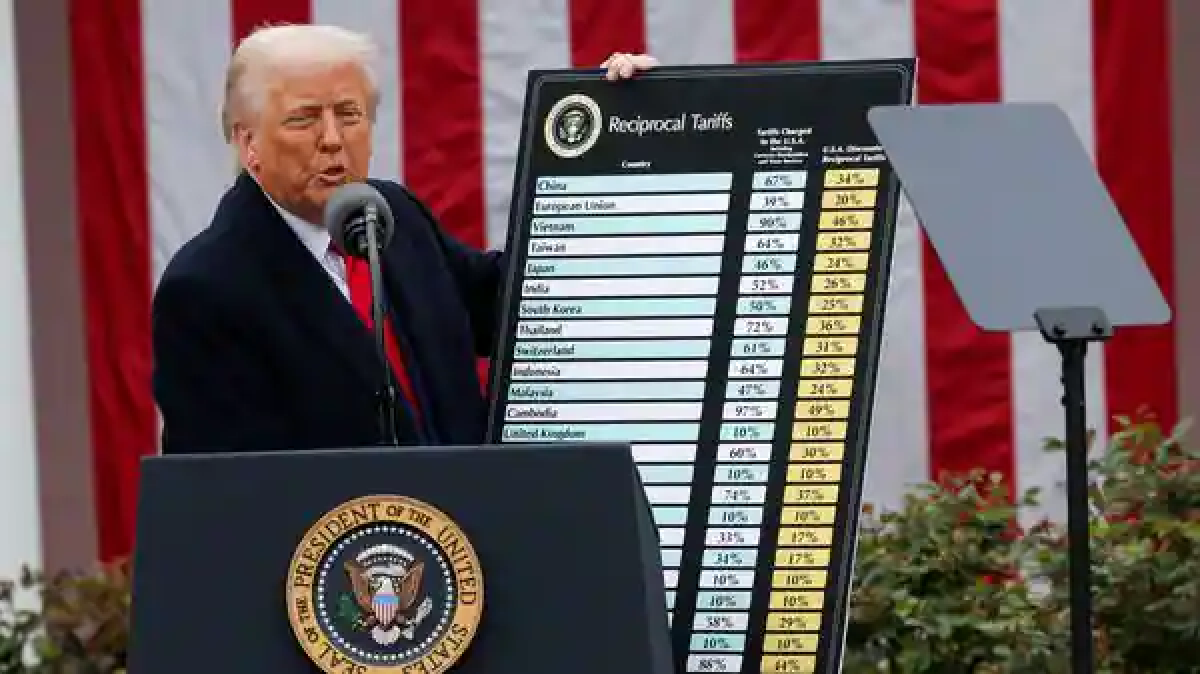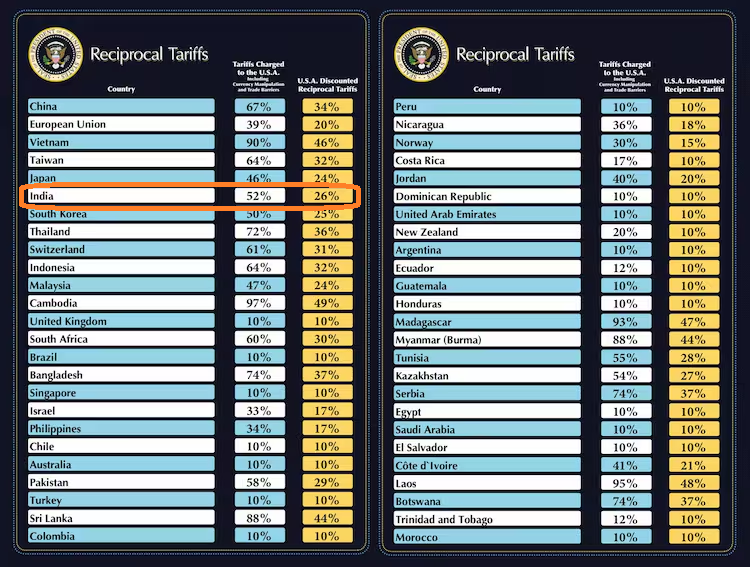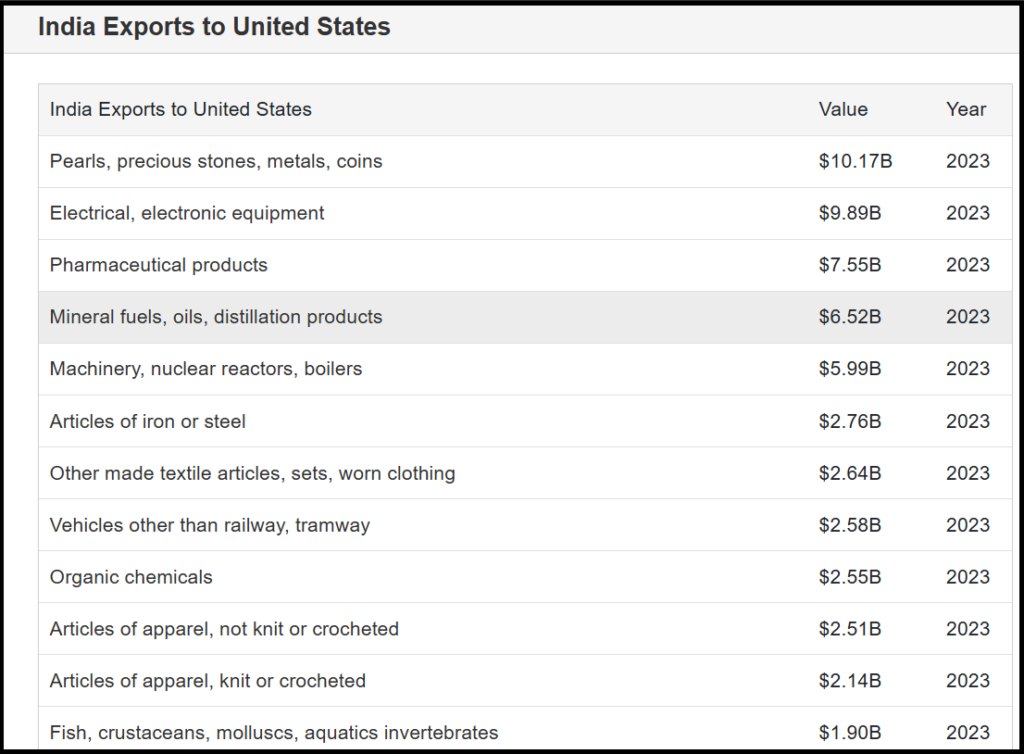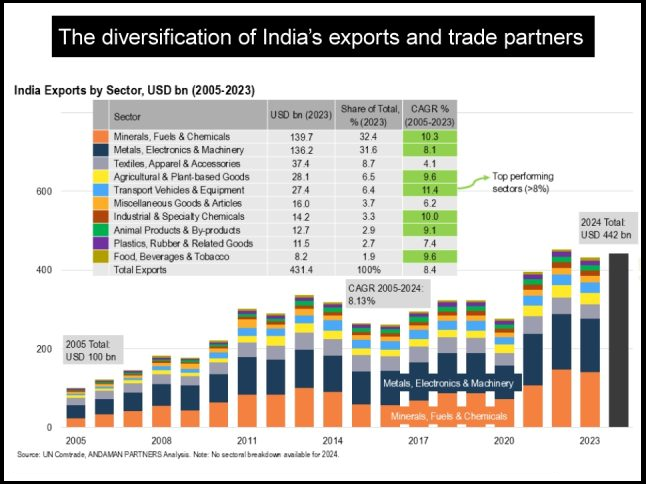
- Though the U.S. continues to remain India’s largest trading partner, this tariff will affect key sectors of industry, GDP growth, trade balances, and investment flows.
- India’s GDP growth is directly correlated with its export performance.
- Though the 26% tariff is a challenge, India has an opportunity at hand to push forward with economic reforms, bolster trade relations with other countries, and develop its indigenous industries.
- The US tariffs on India and other nations have created international economic uncertainty and raised fears of growing trade wars.
The United States, with President Donald Trump at the helm, on April 2, 2025, levied a 26% tariff against Indian imports. The move comes as part of a larger framework aimed at righting trade balances and perceived unfavorable treatment by main trading partners. The tariff placed on India stands relatively lower when compared to its other Asian peers, including 34% imposed on China and 46% on Vietnam. Though the Indian pharma sector, with annual exports of about $9 billion to the U.S., has escaped the situation, other industries, such as electronics and gems and jewellery, which contribute more than $23 billion in exports, are extensively impacted.
Economic Implications for India
The 26% tariff imposed by the United States on Indian exports on April 2, 2025, is likely to have several far-reaching economic implications. Even though the U.S. continues to remain India’s largest trading partner, this tariff will affect key sectors of industry, GDP growth, trade balances, and investment flows. Some of the most important economic implications of the tariff for India are discussed below:
Export Sector Challenges
India’s export-oriented sectors, specifically electronics, gems and jewellery, chemicals, and textiles, will be among the most affected. All these sectors contribute billions of dollars to the Indian economy and depend greatly on the U.S. market. With a tariff of 26%, Indian products will become more expensive to sell in the American market, which will make them less competitive than products from other nations not subject to such heavy duties. India’s rising exports of electronics, including mobile phones and semiconductors, may witness a decrease in demand due to increased prices. The U.S. has been a major destination for Indian electronics, and this level of tariff could prompt American consumers to seek alternative suppliers, such as Vietnam or Taiwan. The gems and jewellery industry, which generates more than $10 billion in exports to the U.S. annually, will also experience lower demand as American consumers seek alternative, lower-priced options from other nations. Indian textile exports, a significant employer in India, will also be impacted, as increased tariffs can make Indian products less affordable in the U.S. market.

Impact on India’s GDP Growth
India’s GDP growth is directly correlated with its export performance. The rise in tariffs will slow the growth of exports, which can, in turn, result in a decrease in overall GDP growth. The tariff is estimated by analysts to cut India’s GDP for the fiscal year 2025-26 by between 0.1% and 0.6%. The fall in exports will also have a cascading impact on industrial production and employment. The MSME (Micro, Small, & Medium Enterprises) sector, which contributes significantly to exports, will bear the brunt of these tariffs, potentially leading to job losses and reduced income for millions of workers.
Trade Deficit and Current Account Deficit (CAD)
If India cannot offset the decline in exports to the U.S. by expanding trade with other nations, the trade deficit can increase further. The current account deficit (CAD) can rise as much as 1.3% of the GDP, adding pressure on India’s foreign exchange reserves. A larger CAD can also depreciate the Indian Rupee, making imports more expensive and fueling inflation.
Foreign Direct Investment (FDI) and Market Sentiment
Tariff imposition can discourage U.S. firms from opening new businesses in India, especially in industries hit by the tariffs. Firms looking at India as a production base under the ‘China Plus One’ policy might rethink their investment strategy amid rising trade uncertainty. While the 26% tariff poses substantial economic challenges for India, it also highlights the imperative of diversifying trade alliances, fortifying indigenous industries, and negotiating more favorable trade conditions with the U.S. With thoughtful economic measures, India can temper the negative impact and establish a more resilient trade system.
Strategic Responses and Opportunities
India’s reaction to the 26% tariff imposed by the United States on April 2, 2025, should be strategic and multi-faceted to limit economic disruption while taking advantage of new opportunities. Though the short-term effect will be tough, India can play on its diplomatic muscle, diversify trade partnerships, and invest in domestic sectors to make the most of the opportunity. Some of the important strategies India should adopt are presented below:

Strengthening Bilateral Trade Negotiations with the U.S.
Diplomatic efforts with the U.S. are important to neutralize the effect of the tariff. India can pursue several negotiation channels. India can insist on sectoral exclusions, especially for sectors where the U.S. has a stake in Indian imports. Pharmaceuticals, for example, are essential to the American healthcare industry, and the provision of continued trade in this sector may help relax tensions. India can use its status as a large importer of U.S. commodities (aircraft, defense hardware, and energy) to secure improved trading terms. By placing mutual advantages at the center, India can try to reduce tariff levels on major exports. Failing negotiations, India can resort to the issue at the World Trade Organization (WTO) by stating that the tariff is protectionist and against principles of fair trade.
Diversifying Trade Partnerships
Decreasing dependence on the U.S. market is essential for long-term economic stability. India can concentrate on Strengthening Free Trade Agreements (FTAs). India has already been negotiating with the European Union, the UK, and the Gulf Cooperation Council (GCC) for trade agreements. Accelerating these negotiations will provide alternative markets and decrease dependence on the U.S. Increasing Trade in Asia and Africa. The Association of Southeast Asian Nations (ASEAN) and African nations are expanding economies with strong demand for Indian commodities. Expanding trade relationships in these regions has the potential to assist Indian exporters in locating new customers. Increased BRICS Cooperation can allow India to utilize mechanisms such as BRICS to consolidate stronger economic connections with expanding markets like Brazil, Russia, China, and South Africa, giving rise to fresh trade opportunities.
Strengthening Domestic Industries
To offset the export losses, India needs to work on enhancing its domestic production and less reliance on imports. Some of the important strategies are enhancing the ‘Make in India’ and PLI Schemes. The Production-Linked Incentive (PLI) scheme must be scaled up to favor industries hit by the tariff, like electronics, textiles, and auto manufacturing. Secondly, build high-value Manufacturing. India has to move away from being a low-cost exporter to a high-value goods producer, i.e., semiconductors, drugs, and high-tech products that are not as vulnerable to the impact of tariffs. Finally, the government should encourage Domestic Consumption. By making the domestic market stronger and increasing consumer demand, India can lower its dependence on foreign markets for economic growth.
Improving Trade Infrastructure and Ease of Doing Business
To induce investors and attract domestic industries, India needs to improve port efficiency, decrease customs clearance time, and simplify export procedures to make Indian exports more competitive in the international market. Streamlining procedures, simplifying regulations and lowering bureaucratic red tape will facilitate the entry of Indian firms into alternative markets. Though the 26% tariff is a challenge, India has an opportunity at hand to push forward with economic reforms, bolster trade relations with other countries, and develop its indigenous industries. With these strategic responses, India is not only able to alleviate losses but can come out stronger and more self-dependent as a world player in trade.
Global Context and Reactions
America’s move to add a 26% reciprocal duty on Indian exports on April 2, 2025, has not merely affected India but has caused a ripple effect in the worldwide trade mechanism that elicited heated responses from diverse nations and multinational agencies alike.
The Tariff Policy of America and Its Foreign Consequences
The duty on Indian imports is one of a larger group of duties applied to key economies, including China (34%), Vietnam (46%), European Union (20%), Japan (24%) and South Korea (26%). They are viewed as an extension of Trump’s previous trade war with China and as a move toward returning manufacturing to the U.S. Although India’s tariff is comparatively lower than Vietnam’s and China’s, it remains a substantial hurdle to bilateral trade relations. The U.S. government has rationalized these tariffs on the grounds of protecting “fair trade” and offsetting trade deficits. Nevertheless, most analysts hold the view that such unilateral tariff increases would jeopardize global supply chains, inflate trade tensions, and trigger retaliatory actions by the affected nations.

India’s Response and Strategic Considerations
India has reacted to the imposition of tariffs with careful diplomacy. Expressing concern for the action but highlighting the need for negotiation and dialogue in terms of seeking a mutually agreeable solution.
- One of the countermeasures that India can resort to includes Reciprocal Tariffs.
- Impose the same tariffs on American goods, more so in the areas where the American exports to India are huge, such as agricultural products and industrial equipment.
- India may challenge the tariff in the World Trade Organization (WTO) because it is against international trade norms.
- Building stronger trade relationships with the European Union, ASEAN, and BRICS countries to minimize dependence on the U.S. market.
Responses from Other Large Economies
China: Already embroiled in a long-standing trade war with the U.S., China has vehemently denounced the tariffs as an act of economic aggression. Beijing has threatened countermeasures and is sure to seek alternative markets to compensate for losses.
European Union: The EU, hit by a 20% tariff, has raised alarm at the increasing protectionism of the U.S. and threatened countermeasures. Brussels can seek a WTO dispute settlement mechanism.
Japan & South Korea: The two nations, which enjoy good trade relations with the U.S., are evaluating the effect on their technology and automotive sectors. They will likely seek exemptions or bargain different trade agreements.
ASEAN Nations: Vietnam, which has the highest tariff rate (46%), condemned the action and is contemplating diplomatic moves to lift the restrictions.
Implications for Global Trade and Geopolitics
The tariff war marks a trend towards a more protectionist international trade environment, which may Disrupt Global Supply Chains. Businesses relying on cross-border trade are likely to incur rising costs and delays, impacting sectors like electronics, automobiles, and pharmaceuticals. The International Monetary Fund (IMF) has cautioned that escalating trade tensions may lower world GDP growth by 0.3% to 0.5% during 2025-26. As U.S. tariffs increase, nations could resort to regional trade agreements, like RCEP (Regional Comprehensive Economic Partnership), to improve economic relationships and minimize reliance on the U.S.
The US tariffs on India and other nations have created international economic uncertainty and raised fears of growing trade wars. While India has immediate economic concerns, the crisis also offers a chance to diversify trade, make local industries more robust, and renegotiate improved trade agreements. The next few months will be important in deciding if this tariff war results in a more fractured global trading system or leads to new economic realignments and alliances.
Dr. Nanda Kishor M. S. is an Associate Professor at the Department of Politics and International Studies, Pondicherry University, and former Head of Geopolitics and International Relations at Manipal University. His expertise spans India’s foreign policy, conflict resolution, international law, and national security, with several publications and fellowships from institutions including UNHCR, Brookings, and DAAD. The views expressed are the author’s own.
